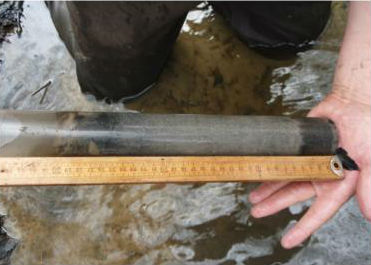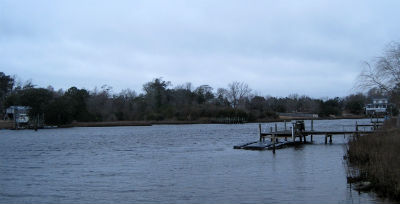Last of two parts
SWANSBORO — Folks who live along Hawkins Creek generally agree that dredging the shallow, polluted stream in the middle of Swansboro would be a huge benefit, opening it to navigation and possibly helping to restore it to better health.
Supporter Spotlight
But dredging creeks like Hawkins that the state considers to be prime water for juvenile fish and shellfish is generally prohibited and terribly expensive. Decades of uncontrolled stormwater runoff got the creek in this fix. Any long-term solution, experts say, includes meaningful measures to stem the flow of poisoned runoff.
The creek is choked with mud and sand, the result of many years of largely uncontrolled runoff. State tests seem to confirm that. Samples of the creek bottom taken in January indicated pollution, and a larger than expected amount of sand.
And a second analysis released this month found high amount of inorganic sand in the upper sections of the creek and organic mud farther downstream. “The apparent stratification and volume of the sand in the stream bed is indicative of long-term deposition from multiple sources, most likely related to stormwater drainage over a period of time,” the report concludes.

Hawkins, the report notes, is characterized by shorelines that are 76 percent developed, with approximately 22 percent of its shoreline covered by impervious surface. The banks of its upper reaches, close to N.C. 24, are heavily scoured from flash floods of runoff.
“The tidal section of Hawkins Creek has been channelized in the past,” the report states. “However much of it has since filled in. Adjacent to the creek are neighborhoods, with retaining walls in place to limit erosion. Sediment barriers are also prevalent on the majority of the western bank of Hawkins Creek.”
Supporter Spotlight
Dredging could help, but Jim Gregson, supervisor of the surface water protection section of the N.C. Division of Water Resources in Wilmington, realizes, as does everyone else, that obtaining a permit to dredge the troubled creek won’t be easy. The N.C. Division of Marine Fisheries has long listed Hawkins as a primary nursery area, or prime habitat for juvenile fish and shellfish, and dredging in such areas is generally prohibited.
Nor does anyone have a good idea yet of what it will cost to dredge the creek or who will pay for it. Without effectively controlling the amount of runoff entering the creek, dredging is a temporary fix that would eventually have to be done again. Stirring up the bottom also risks dispersing pollutants now fixed in the mud.
The permit, though, is the first problem. Just how hard would it be?
State law notes that dredging in primary nursery areas “shall be avoided” except – there’s always an “except” — to maintain an existing natural or man-made channel that was either permitted or used continuously if dug before the days of permits. Applicants must prove that dredging is needed to support a water-dependent activity and must place any dredged material someplace where it won’t adversely affect the nursery area.
Eddie Privett and Alex Moore think Hawkins can be dredged while following the law. They live on opposite sides of the creek. Privett is a commercial fisherman, and Moore built a dredge boat and got a permit decades ago to open what he says was a natural channel.
“It was used,” Moore said of the channel. “It was used a lot.”
Roy Brownlow is the Morehead City district manager for the state Division of Coastal Management, the agency that would permit any dredging operation. Getting a dredging permit is possible, he said, but it’s not easy to overcome the nursery status.
“You have to have documentation that you meet the criteria,” he said. “Sometimes that can be pretty challenging, especially for areas that might have been dredged, but not for a long time. In some cases, there are aerial maps (from which) you can actually see the channels. Sometimes people have old permits. But sometimes there just isn’t any proof.”

Even with proof, applicants would have high hurdles to clear, Brownlow said. His agency can’t issue general permits for dredging in nursery areas, he explained. Applicants would have to apply for an individual, major permit. Those applications are reviewed by a dozen or so state and federal agencies, including the state’s fisheries and water quality divisions, the National Marine Fisheries Service and the Army Corps of Engineers. Any of them could raise objections that could scuttle a permit application or impose stringent conditions on when, where and how the work could be done.
The major concerns, Brownlow said, are to avoid damage to submerged sea grasses and other important habitat and to avoid disrupting key points in the life cycles of the fish and shellfish that use those habitats.
Some people, though, aren’t sure that Hawkins should be considered a fish nursery anymore. Much of the creek, according to Privett, has so much silt that it doesn’t support much life. In some places, there’s so much sand that it’s more akin to hard bottom than the soft mud generally associated with healthy, coastal creeks, Privett said, and that observation was born out by samples the state has taken in the past couple of months.
Doris Shelton, who like Privett has lived on Hawkins for decades, said she’s seen a marked decrease in the number of birds feeding in the creek and in the quantity of fish and shrimp.
Ann Deaton, who is chief of the fisheries division’s habitat protection section based in Morehead City, said anecdotal observations can be misleading and cautioned that hard, sandy-bottom creeks can be important nursery areas. They can be very productive, especially for juvenile fish, she said.
It’s possible, Deaton explained, to re-classify primary nursery areas, but it generally takes several years of sampling marine life to make that determination.
The division routinely samples nursery areas, but doesn’t do the same areas each year. Sometimes, Deaton said, the division does respond to requests to sample specific areas, and the N.C. Marine Fisheries Commission, the policy-making arm of the division, has raised some questions about the whole nursery-designation issue.
“We are putting together some information and will present it to the commission at some point,” she said.
The creek has been closed to shellfishing since at least 1952, when Swansboro started dumping its treated sewage into Foster’s Bay. The town removed the discharge in 2008. But that has no bearing on whether the creek is a functional nursery area, said Shannon Jenkins, an environmental specialist with the state Shellfish Sanitation and Recreational Water Quality Section, also based in Morehead City. And Hawkins, he said, is not unlike many, if not most, urban coastal creeks in that respect.
“There are really not many that are open,” he said. “Most are closed because of stormwater runoff, which carries bacteria, and there really isn’t enough tidal flow to clean them out, in most cases.”
Dredging could help, but there’s not much chance the creek will reopen to shellfishing. Jenkins said that although closures sometimes are reversed, it’s rare in urban creeks subject to heavy runoff.
Privett said he would consider starting a petition to get Hawkins dredged, and John Freshwater, a developer and engineer who also lives on the creek, said he’s also in favor of it.

But, Freshwater said, it would be essential to address the sources of the sediment, too, either before or concurrent with dredging, or the creek would simply fill in again. The town and the state Department of Transportation would need to improve retention of sediments from N.C. 24, and the town might need to consider tougher stormwater rules.
Scott Chadwick, the town’s mayor, said that when he took office, he thought the town should consider adopting a stormwater plan. The town commissioners considered doing so a couple a times in the last few years, but decided each time that state rules were adequate.
“I’d still like to see us consider looking at our own rules,” Chadwick said recently. “I’d also like to see the creek dredged.”
Swansboro Commissioner Jim Allen, who lives on Broad Street, near Hawkins, also said he’d like to see the creek dredged and would like DOT to do more to both improve drainage and catch sediments in the area where Hawkins Creek goes under N.C. 24.
“When those two (washouts) happened, a tremendous amount of sand and dirt went into the creek, and it will happen again,” he said. “Those drains fill up and they just can’t handle all the rain we sometimes get. The water just gushes into the creek and the banks can’t handle that, and they start getting cut away. And that’s just when we get a normal heavy rain. When we get a hurricane…”
The likelihood of dredging is slim and its effects questionable without a commitment to control runoff. Even so, said Gregson, there are numerous things individual property owners could do to help, such as not mowing their lawns right down to the creek, improving their bulkheads to stop sediment from leaching through and planting rain gardens to catch runoff. Those kinds of things and dozens of other smaller-scale measures, such as planting marsh grass and catching rain in barrels to reuse later are what the N.C. Coastal Federation recommends. The environmental group, headquartered nearby in Carteret County, has decades of experience in helping people control runoff. It’s worked for years, for instance, with Cedar Point, just across the White Oak River, on projects to control runoff into the lower river.
Todd Miller, founder and executive director of the federation, said the group would be happy to work with those who want to improve the creek, especially if invited by residents.
“Small-scale efforts on individual properties” are the most economical and often the best way, even the only way, to effectively address water quality problems, he said, particularly in areas, like Hawkins Creek where the shores are largely or totally developed.
“The goal back when these areas were developed was to get the stormwater off the property,” Miller said, whereas the goal now is to keep it there and let nature filter the sediments and pollution, adhering as closely as possible to the natural systems in place before the development occurred.
“There are some very inexpensive retrofits that can make a big difference,” he said. For example, N.C. State did a study that found that a $10 retrofit – a downspout diverter – to direct stormwater into grass or a rain garden instead of onto a hard surface, such as a driveway or patio can reduce stormwater discharge and pollution by 70 to 90 percent.
“You want to get the stormwater back into the ground,” Miller said. “You want it to run through vegetation.”
Freshwater said he’d like to see a broad-based effort. “I’d like to see everyone who has a stake in Hawkins Creek get together and talk about what we can do,” he said.







